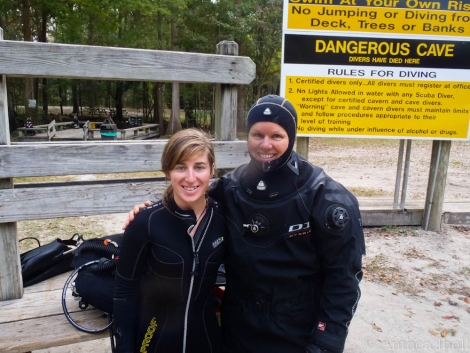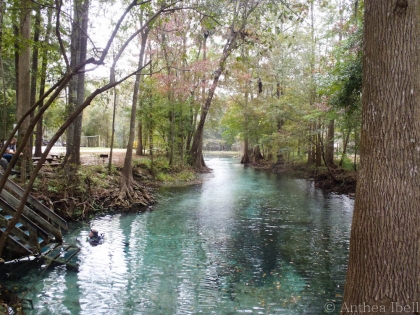Ever since I started diving I have been intrigued by cave diving. My instructor on my Open Water Course told stories of her dives in the Cenotes in Mexico and I daydreamed of the day. I was fortunate enough to fill an open space in one of Jill Heinerth’s Cavern and Basic Cave course in North Florida. Jill is one of the most admirable people I have ever met. She is not only an amazing cave diver; she is a filmmaker, photographer and an incredible explorer. She has taken part in, and organised expeditions all over the world. Christian Clark, the current North American scholar has had training with Jill during his scholarship year and is hooked. After witnessing his passion for the fresh water ecosystems I jumped at the opportunity to do an introductory course myself.
We started with lectures covering the National Speleological Society (NSS) Cave course, the limitations of our training, the basics of cave diving and the geology of caves. The course was my first time in a Doubles set up so we had an open water dive in Ginnie Springs where I was able to get a feel for the new equipment and practice laying lines.
The second dive of the course was into Devil’s Eye at Ginnie Springs. Swimming down into the cave was a strange experience. With the new equipment, tasks at hand, and thought of an overhead environment all on my mind, I didn’t have a real chance to sit back and take it all in until the third dive of the day, when Jill took me for a tour of ‘Devils Ear’. Following closely behind her in the corridors, her slow frog kicks relaxed me and made me fully appreciate where I was – I am cave diving with Jill Heinerth! The corridors were quite large and we swum along in the centre, not to kick up the sand on the bottom. Around a turn we arrived at ‘the lips’, tight limestone shelves. The blue glow from the lights made it even more surreal and I enjoyed every second of it.
By the end of the course we had covered out of air, no mask, lost diver, and the most interesting skill of all; lost line. The lost line drill simulates a silt-out, a situation that would be quite easy to get yourself into. We were blindfolded and put in a spot away from the mainline. For this you tie off a safety line and swim close to the bottom, the walls and along the ceiling, hoping to catch or run into the mainline. The trick is to always make a mental note of where the mainline is in the cave as you make your way through – that way, if a silt out occurs you have a mental map of where you have been and can use tangible clues to find the line and your way out. It took me 30minutes to find the line, and when I did I realised that I had been placed quite close to it in the first place! It was a very valuable practice!
I can’t thank Jill enough, not only for introducing me to this incredible new environment but her calm and respectful attitude, not to mention her great story telling. Riana Treanor, a colleague of Jill’s was kind enough to put me up and give me many wise words throughout my stay in North Florida. I feel lucky to have met two very passionate and inspiring women!






